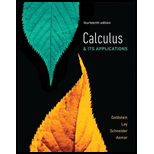
Concept explainers
Savings Account Let
a. If after
b. Write the differential equation in the form
c. Describe the differential equation in words.
Want to see the full answer?
Check out a sample textbook solution
Chapter 10 Solutions
Calculus & Its Applications (14th Edition)
- Please refer belowarrow_forwardHi, can you guys help me with this? Thank you! Can you guys help me calculate again the Term GPA, Combined GPA, Cumulative GPA, Transfer GPA & Combined Cumulative GPA section? It's just not right right now. Here's the transfer totals point that I want to provide just in case you guys may ask where I get these from:arrow_forwardUse undetermined coefficients to find the particular solution to y"-3y+2y=4e3 Y(t) =arrow_forward
- Question attachedarrow_forwardThe graph of f(x) is given in the figure below. draw tangent lines to the graph at x=-3,x=-2,x=1,and x=4. estimate f'(-3),f'(-2),f'(1),and f'(4). Round your answers to one decimal place.arrow_forwardConsider the functions f(x)=4x-1 and g(x)=sq root of -x+7. Determine 1. f o g(x) 2. Give the domain of f o g(x) 3. g o f (x) 4. Give the domain of g o f(x)arrow_forward


 Glencoe Algebra 1, Student Edition, 9780079039897...AlgebraISBN:9780079039897Author:CarterPublisher:McGraw Hill
Glencoe Algebra 1, Student Edition, 9780079039897...AlgebraISBN:9780079039897Author:CarterPublisher:McGraw Hill- Algebra & Trigonometry with Analytic GeometryAlgebraISBN:9781133382119Author:SwokowskiPublisher:Cengage



